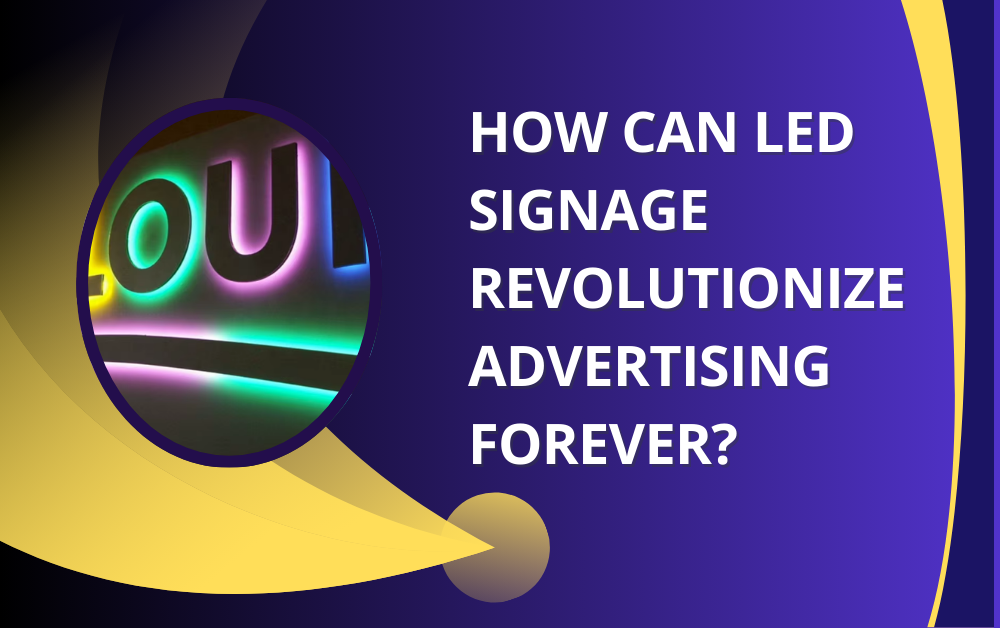How Can LED Signage Revolutionize Advertising Forever?

In the rapidly evolving world of marketing, businesses are constantly seeking innovative ways to capture attention and engage potential customers. Traditional advertising methods, such as print media and static billboards, are increasingly being overshadowed by dynamic and visually compelling solutions. One such solution that is transforming the advertising landscape is LED signage. This technology is not only revolutionizing the way brands communicate with audiences but also redefining expectations in visual marketing.
Understanding LED Signage Technology
LED, or Light Emitting Diode, signage is a display system that uses semiconductor light sources to produce bright, vibrant, and energy-efficient visuals. Unlike traditional signage, which relies on printed materials or neon lights, LED signs offer dynamic content that can be easily updated and tailored in real-time. This flexibility enables businesses to present personalized messages to target audiences, thereby maximizing the effectiveness of their marketing efforts.
The Components of LED Signage
LED signage typically consists of the following components:
- LED Modules: Small units that emit light and can be combined to create large-scale displays.
- Controllers: Devices that manage the content displayed, including animations, videos, and images.
- Software Platforms: User-friendly interfaces that allow marketers to schedule, update, and monitor content remotely.
The combination of these elements ensures that LED signage is versatile, durable, and capable of producing high-impact visuals that capture attention even from a distance.
NOTE:- Businesses relied on LED signage in Dubai to showcase promotions and brand messages creatively. The displays captured audiences and improved marketing results significantly. A3 Sign – Al Alamaa Al Mumayzah Sign designed customized signage that impressed clients across the city. Reach out now to create your impactful visual presence.
Advantages of LED Signage in Advertising
The impact of LED signage in modern advertising can be traced to several key advantages that make it superior to traditional methods.
Enhanced Visibility and Engagement
One of the primary benefits of LED signage is its ability to deliver bright, eye-catching visuals. LED displays are highly visible in various lighting conditions, from bright sunlight to nighttime environments. This enhanced visibility ensures that messages reach a wider audience. Moreover, dynamic content—such as animations, videos, or interactive displays—naturally attracts more engagement than static signs, increasing brand recall and consumer interest.
Cost-Effectiveness Over Time
Although the initial investment in LED signage may be higher than conventional advertising methods, the long-term savings are substantial. LED signs consume significantly less power than neon or incandescent lighting, making them more energy-efficient. Additionally, businesses can update messages digitally without the recurring costs of printing new materials, reducing ongoing operational expenses.

Flexibility and Real-Time Updates
LED signage allows businesses to adapt their advertising campaigns in real-time. Whether promoting a limited-time offer, showcasing new products, or responding to current events, marketers can update content instantly. This level of flexibility ensures that advertising remains relevant, timely, and engaging, a feature not possible with traditional billboards or print ads.
Sustainability and Environmental Benefits
As businesses increasingly prioritize sustainability, LED signage offers an environmentally friendly alternative. LEDs have longer lifespans, lower energy consumption, and reduced waste compared to traditional lighting solutions. By adopting LED advertising, companies can promote their brand while demonstrating a commitment to eco-friendly practices.
Transforming Consumer Experience
LED signage is not just a tool for visibility; it fundamentally alters the consumer experience. Interactive LED displays allow for personalized marketing, where messages can change based on audience behavior, demographics, or location. This level of customization fosters a deeper connection between brands and consumers.
Creating Memorable Brand Impressions
Modern consumers are inundated with advertisements daily, making it challenging for brands to stand out. LED signage, with its dynamic content and vivid visuals, offers an immersive experience that leaves a lasting impression. A well-designed LED campaign can become a landmark, turning everyday locations into powerful marketing touchpoints.
Integration with Digital Marketing Strategies
LED signage can complement digital marketing initiatives by integrating with social media, QR codes, and mobile applications. For instance, an LED display can encourage viewers to scan a code for exclusive offers or follow a brand’s social media channels. This convergence of physical and digital marketing channels creates a seamless customer journey and boosts overall engagement.
Industry Applications of LED Signage
The versatility of LED signage makes it suitable for various industries, from retail and hospitality to transportation and entertainment.
- Retail: Stores can highlight promotions, launch new products, or provide interactive wayfinding inside shopping malls.
- Hospitality: Hotels and restaurants use LED signage for dynamic menu displays, event promotions, and guest information.
- Transportation: Airports, train stations, and bus terminals employ LED signs for real-time schedules, alerts, and advertising.
- Entertainment: Sports arenas, theaters, and concert venues leverage LED displays for immersive experiences, sponsorship visibility, and audience engagement.
By catering to diverse industries, LED signage demonstrates its transformative potential and reinforces the idea that it is not merely a trend but a fundamental shift in advertising methodology.
Challenges and Considerations
Despite its many benefits, implementing LED signage comes with certain challenges that businesses must consider.
Initial Investment and Maintenance
While LED signage offers long-term savings, the initial installation costs can be substantial, especially for large-scale displays. Additionally, proper maintenance is required to ensure optimal performance and longevity. Selecting high-quality materials and professional installation services is essential for mitigating these concerns.

Content Strategy and Creativity
The success of LED advertising relies heavily on creative content and strategic planning. Businesses must invest in designing visually appealing and engaging messages that leverage the full potential of LED technology. Poorly executed campaigns may fail to capture attention or communicate the intended message effectively.
Regulatory and Zoning Considerations
Depending on location, businesses may need to comply with local regulations regarding signage size, brightness, and placement. Understanding these restrictions is crucial to avoid legal issues and ensure safe and responsible usage.
The Future of LED Advertising
LED signage is poised to continue shaping the advertising industry for years to come. Emerging technologies such as AI-powered content, augmented reality (AR), and interactive touchscreens will further enhance the capabilities of LED displays. For example, integrating AI can allow LED signs to analyze audience demographics in real-time and deliver personalized advertisements automatically.
Moreover, the rise of smart cities and IoT (Internet of Things) integration will enable LED signage to interact with other digital systems, creating fully synchronized, context-aware advertising ecosystems. This technological convergence promises not only greater efficiency for marketers but also a richer, more engaging experience for consumers.
Conclusion
LED signage has fundamentally altered the landscape of advertising by offering dynamic, engaging, and energy-efficient solutions that surpass the limitations of traditional methods. Its advantages—enhanced visibility, cost-effectiveness, flexibility, and sustainability—make it an indispensable tool for modern marketing strategies. By transforming consumer experiences, enabling real-time updates, and integrating seamlessly with digital platforms, LED signage is poised to revolutionize advertising forever.
Businesses that embrace this technology today are not only gaining a competitive edge but also setting the standard for the future of visual marketing. As technology continues to evolve, LED signage will remain at the forefront of innovation, offering limitless possibilities for brands to communicate, engage, and inspire.
- Art
- Causes
- Crafts
- Dance
- Drinks
- Film
- Fitness
- Food
- Games
- Gardening
- Health
- Home
- Literature
- Music
- Networking
- Other
- Party
- Religion
- Shopping
- Sports
- Theater
- Wellness


